fuel PORSCHE 911 CARRERA 2011 6.G Information Manual
[x] Cancel search | Manufacturer: PORSCHE, Model Year: 2011, Model line: 911 CARRERA, Model: PORSCHE 911 CARRERA 2011 6.GPages: 63, PDF Size: 9.45 MB
Page 19 of 63

462135
7R
3839
Porsche Doppelkupplung (PDK).
Available as an option for the new 911
models is 7-speed PDK, featuring manual
and automatic modes. This double - clutch
transmission has been further refined and
enables extremely fast gear changes with
no interruption in the flow of power, which vastly improves acceleration at the
same time as reducing fuel consumption.
In total, PDK has seven gears at its disposal.
Gears 1 to 6 have a sports ratio and top
speed is reached in 6th gear. 7th gear has
a long ratio and helps to reduce fuel
consumption by keeping engine revs low.
Porsche Doppelkupplung (PDK)
PDK is essentially t wo gearboxes in one
and thus requires t wo clutches. This
double-clutch arrangement provides an
alternating, non-positive connection
bet ween the t wo half gearboxes and the
engine by means of t wo separate input
shafts.The flow of power from the engine is
transmit ted through one half gearbox and
one clutch at a time, while the next gear
is preselected in the second half gearbox.
During a gear change, therefore, one
clutch simply opens and the other closes
at the same time, enabling gear changes
to take place within milliseconds.
Temperament | Transmission
The effect is instant. Driving feels even
sportier and more dynamic, and agility
is increased. Depending on the gearshift
programme (SPORT button activated
or deactivated), the gear change is opti -
mised for comfort or for sport y driving.With the optional Sport Chrono Package,
PDK is enhanced by the ‘Launch Control’
and ‘motorsport- derived gearshif t strategy’
functions (p. 50). In this way, optimum use is made of the
vehicle’s momentum, allowing it to coast
for longer distances.
For example, you may want to slow down
from 100 km/ h (62 mph) to 80 km/ h
(49 mph) in anticipation of the change of
speed limit ahead. As soon as you release
the accelerator pedal, PDK deselects
the current gear automatically and you
begin to coast in neutral until you have
reached your desired speed. The moment
you engage the accelerator or brake
pedal, PDK selects the appropriate gear
smoothly and seamlessly within a fraction
of a second.
Another way to reduce fuel consumption is
to utilise the coasting function on downhill
gradients that are gentle enough for you
to maintain a constant speed. Efficient on
long journeys, such as on the motorway,
PDK remains ready to respond as swiftly
and precisely as you would expect.
In short, driving in coasting mode makes
a real impact on fuel consumption without
any need for compromise on comfort or
sporty performance.
Coasting.
The ‘coasting’ function available with
Porsche Doppelkupplung (PDK) enables
you to save even more fuel where the
situation allows. The engine is decoupled
from the transmission to prevent
deceleration caused by engine braking.
Page 21 of 63
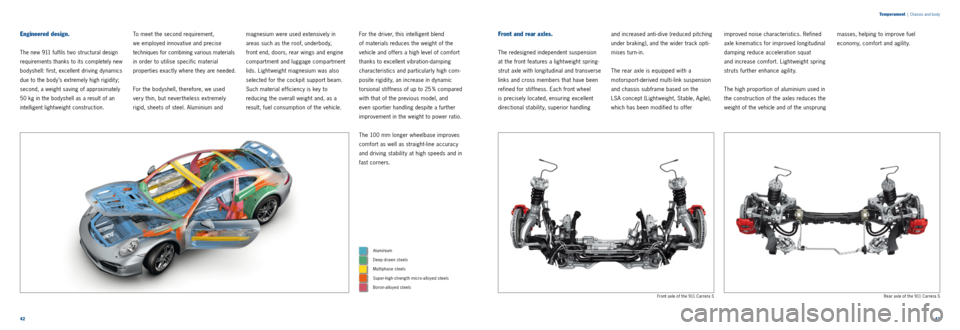
4243
Temperament
| Chassis and body
Engineered design.
The new 911 fulfils two structural design
requirements thanks to its completely new
bodyshell: first, excellent driving dynamics
due to the body’s extremely high rigidit y;
second, a weight saving of approximately
50 kg in the bodyshell as a result of an
intelligent lightweight construction.
To meet the second requirement,
we employed innovative and precise
techniques for combining various materials
in order to utilise specific material
properties exactly where they are needed.
For the bodyshell, therefore, we used
very thin, but nevertheless extremely
rigid, sheets of steel. Aluminium and magnesium were used extensively in
areas such as the roof, underbody,
front end, doors, rear wings and engine
compartment and luggage compartment
lids. Light weight magnesium was also
selected for the cockpit support beam.
Such material efficiency is key to
reducing the overall weight and, as a
result, fuel consumption of the vehicle. For the driver, this intelligent blend
of materials reduces the weight of the
vehicle and offers a high level of comfort
thanks to excellent vibration-damping
characteristics and particularly high com -
posite rigidit y, an increase in dynamic torsional stiffness of up to 25 % compared
with that of the previous model, and
even
sportier handling despite a further
improvement in the weight to power ratio.
The 100 mm longer wheelbase improves
comfort as well as straight-line accuracy
and driving stabilit y at high speeds and in
fast corners.
Front and rear axles.
The redesigned independent suspension
at the front features a light weight spring-
strut axle with longitudinal and transverse
links and cross members that have been
refined for stiffness. Each front wheel
is precisely located, ensuring excellent
directional stability, superior handling and increased anti-dive (reduced pitching
under braking), and the wider track opti
-
mises turn-in.
The rear axle is equipped with a
motorsport-derived multi-link suspension
and chassis subframe based on the
LSA concept (Lightweight, Stable, Agile),
which has been modified to offer improved noise characteristics. Refined
axle kinematics for improved longitudinal
damping reduce acceleration squat
and increase comfort. Light weight spring
struts further enhance agilit y.
The high proportion of aluminium used in
the construction of the axles reduces the
weight of the vehicle and of the unsprung masses, helping to improve fuel
economy, comfort and agility.
Rear axle of the 911 Carrera S
Front axle of the 911 Carrera S
Aluminium
Deep-drawn steels
Multiphase steels
Super-high-strength micro-alloyed steels
Boron-alloyed steels
Page 26 of 63

5253
Wheels.
On the new 911, the wheels have been
enlarged by one inch over the previous
model. Not only do the larger wheels
improve dynamic performance, they
also look more imposing.
The new 911 Carrera is equipped with
19-inch Carrera wheels as standard. These are light weight alloys featuring
a classic sport y design. Tyre sizes are
235/40 ZR 19 and 285/35 ZR 19 at
the front and rear respectively.
The S model is equipped with light-alloy
20 -inch Carrera S wheels as standard.
The visual effect is sport y and dynamic.
The t yres are slightly wider to cope
with the increased power output of this model: 245/35 ZR 20 at the front,
295/30 ZR 20 at the rear.
The larger t yre size improves both ride
comfort and track performance. The
rolling resistance of the summer t yres
has been reduced by up to 7 % to improve
fuel economy, while t yre weight and dry
braking distances have also been
reduced. A selection of 20-inch wheels is available in
our range of options.
Tyre Pressure Monitoring (TPM).
Tyre Pressure Monitoring (TPM) is available
on request. This safet y system sends
warnings to the on-board computer’s
display screen in the event of low t yre
pressure or a gradual or sudden loss
of pressure. The individual pressures
in all four t yres can be displayed in the
instrument cluster.
Porsche Stability Management (PSM).
As standard, the new 911 models
are equipped with enhanced Porsche
Stabilit y Management (PSM), which
maintains stability even at the limits of
dynamic driving performance. Sensors
continuously monitor the direction,
speed, yaw velocity and lateral acceleration
of the car. Using this information, PSM is able to calculate the actual direction
of travel at any given moment. If the car
begins to oversteer or understeer, PSM
applies selective braking on individual
wheels to restore stabilit y.
Under acceleration on wet or low-grip
road surfaces, PSM improves traction
using the automatic brake differential
(ABD), anti-slip regulation (ASR) and
engine drag torque control (EDC) function.
When the SPORT PLUS mode of the
optional Sport Chrono Package is selected,
the PSM threshold is raised to allow a
sportier driving st yle.
For an even more dynamic experience,
you always have the option to deactivate
PSM. It is automatically reactivated,
for your safet y, only if you brake harder
and either of the front wheels (in SPORT
PLUS mode, both of the front wheels)
requires ABS assistance. ABS and ABD,
however, remain active at all times.
PSM therefore offers a high level of
driving stability and safety combined
with extraordinary agilit y. It ’s an
apparent contradiction in terms, but an
intrinsic part of the Porsche identit y.
19-inch Carrera wheel (standard on the 911 Carrera)
20-inch Carrera S wheel (standard on the 911 Carrera S)911 Carrera S with 20-inch Carrera Classic wheels
Temperament | Chassis and body
Page 30 of 63
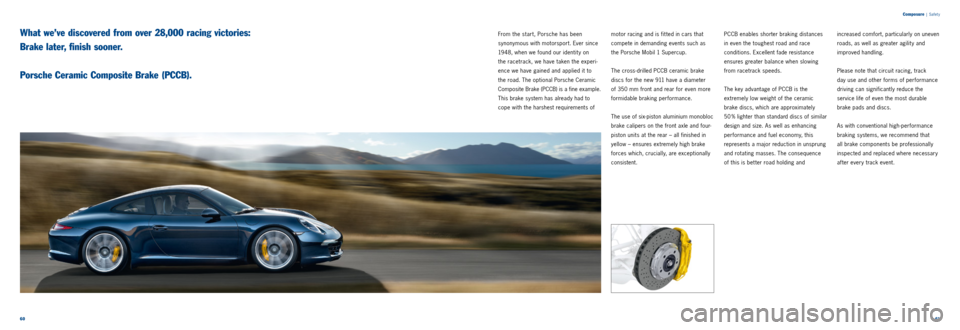
6061
From the start, Porsche has been
synonymous with motorsport. Ever since
1948, when we found our identit y on
the racetrack, we have taken the experi -
ence we have gained and applied it to
the road. The optional Porsche Ceramic
Composite Brake (PCCB) is a fine example.
This brake system has already had to
cope with the harshest requirements of
Composure | Safet y
motor racing and is fit ted in cars that
compete in demanding events such as
the Porsche Mobil 1 Supercup.
The cross-drilled PCCB ceramic brake
discs for the new 911 have a diameter
of 350 mm front and rear for even more
formidable braking performance.
The use of six-piston aluminium monobloc
brake calipers on the front axle and four-
piston units at the rear – all finished in
yellow – ensures extremely high brake
forces which, crucially, are exceptionally
consistent. What we’ve discovered from over 28,000 racing victories:
Brake later, finish sooner.
Porsche Ceramic Composite Brake (PCCB).PCCB enables shorter braking distances
in even the toughest road and race
conditions. Excellent fade resistance
ensures greater balance when slowing
from racetrack speeds.
The key advantage of PCCB is the
extremely low weight of the ceramic
brake discs, which are approximately
50 % lighter than standard discs of similar
design and size. As well as enhancing
performance and fuel economy, this
represents a major reduction in unsprung
and rotating masses. The consequence
of this is bet ter road holding and increased comfort, particularly on uneven
roads, as well as greater agilit y and
improved handling.
Please note that circuit racing, track
day use and other forms of performance
driving can significantly reduce the
service life of even the most durable
brake pads and discs.
As with conventional high-performance
braking systems, we recommend that
all brake components be professionally
inspected and replaced where necessary
after every track event.
Page 34 of 63
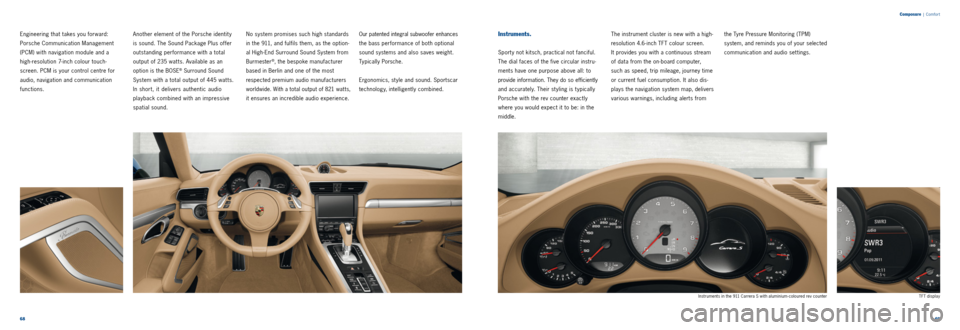
6869
Composure
| Comfor t
Engineering that takes you forward:
Porsche Communication Management
(PCM) with navigation module and a
high-resolution 7-inch colour touch -
screen. PCM is your control centre for
audio, navigation and communication
functions.Instruments.
Sporty not kitsch, practical not fanciful.
The dial faces of the five circular instru -
ments have one purpose above all: to
provide information. They do so efficiently
and accurately. Their st yling is t ypically
Porsche with the rev counter exactly
where you would expect it to be: in the
middle.
Another element of the Porsche identit y
is sound. The Sound Package Plus offer
outstanding performance with a total
output of 235 wat ts. Available as an
option is the BOSE
® Surround Sound
System with a total output of 445 wat ts.
In short, it delivers authentic audio
playback combined with an impressive
spatial sound. No system promises such high standards
in the 911, and fulfils them, as the option
-
al High-End Surround Sound System from
Burmester
®, the bespoke manufacturer
based in Berlin and one of the most
respected premium audio manufacturers
worldwide. With a total output of 821 wat ts,
it ensures an incredible audio experience. Our patented integral subwoofer enhances
the bass performance of both optional
sound systems and also saves weight.
Typically Porsche.
Ergonomics, st yle and sound. Sportscar
technology, intelligently combined.
The instrument cluster is new with a high-
resolution 4.6-inch TFT colour screen.
It provides you with a continuous stream
of data from the on-board computer,
such as speed, trip mileage, journey time
or current fuel consumption. It also dis -
plays the navigation system map, delivers
various warnings, including alerts from the Tyre Pressure Monitoring (TPM)
system, and reminds you of your selected
communication and audio settings.
TFT display
Instruments in the 911 Carrera S with aluminium - coloured rev counter
Page 48 of 63
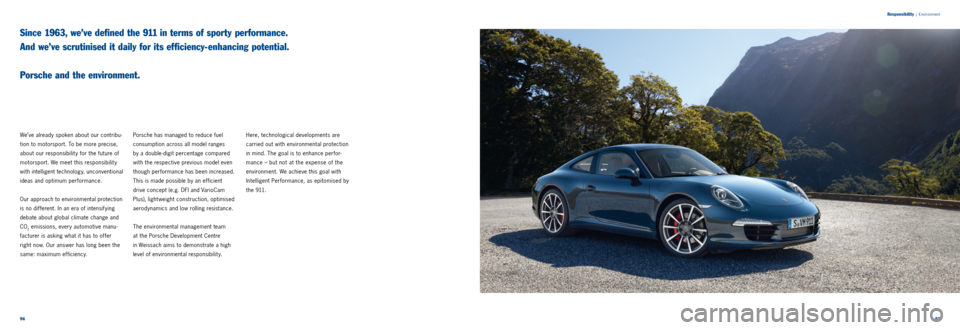
9697
Responsibility
|
Environment
Since 1963, we’ve defined the 911 in terms of sporty performance.
And we’ve scrutinised it daily for its efficiency-enhancing potential.
Porsche and the environment.
We’ve already spoken about our contribu -
tion to motorsport. To be more precise,
about our responsibility for the future of
motorsport. We meet this responsibility
with intelligent technology, unconventional
ideas and optimum performance.
Our approach to environmental protection
is no different. In an era of intensifying
debate about global climate change and
CO
2 emissions, every automotive manu -
facturer is asking what it has to offer
right now. Our answer has long been the
same: maximum ef ficiency. Porsche has managed to reduce fuel
consumption across all model ranges
by a double-digit percentage compared
with the respective previous model even
though performance has been increased.
This is made possible by an efficient
drive concept (e.g. DFI and VarioCam
Plus), lightweight construction, optimised
aerodynamics and low rolling resistance.
The environmental management team
at the Porsche Development Centre
in Weissach aims to demonstrate a high
level of environmental responsibility. Here, technological developments are
carried out with environmental protection
in mind. The goal is to enhance perfor
-
mance – but not at the expense of the
environment. We achieve this goal with
Intelligent Performance, as epitomised by
t h e 911.
Page 49 of 63

9899
Responsibility
|
Environment
Exhaust emission control.
Vehicles manufactured by Porsche
demonstrate that even high-performance
sportscars can achieve moderate
fuel consumption and exhaust emission
values in their respective category.
This is achieved, on the one hand,
through the use of fuel-efficient technolo -
gies such as auto start/stop, thermal
management, electrical system recupera -
tion, direct fuel injection, coasting mode
and VarioCam Plus.
On the other hand, newly developed
cataly tic converters provide ef ficient
emission control.
The stereo Lambda control circuitr y
controls and monitors each cylinder bank
separately. For each exhaust tract,
oxygen sensors regulate the composition
of the exhaust gas, while another Lambda
sensor on each cylinder bank monitors pollutant conversion in the respective
cataly tic converter.
1)
Fuel economy and recycling.
Intelligent light weight construction has
been fundamental to the Porsche identit y
since 1948, for both economic and
ecological reasons. This forms the basis
for achieving low fuel consumption
values in conjunction with outstanding
performance.
It is economical thanks to the high
proportion of aluminium, magnesium,
plastics and super- high -strength sheet
steel used. This is substantially more
stable and lighter than conventional steel.
It is also ecological because all materials
used are meticulously selected. We use
only innovative and environmentally friendly
components. All light weight materials are
easily recyclable and each material is labelled to facilitate its separation for
recycling. The reduction in the number
of plastic variants helps to ensure more
ef ficient recycling. Recycled plastics
are used where they meet our exacting
technical requirements.
In short, the new 911 is up to around
95 % recyclable.
In addition, Porsche for the most part
uses environmentally friendly water-
based paints. For us, environmental
protection does not begin at the end
of a vehicle’s life. It starts at the planning
and development stage.
Fuel.
All Porsche models – including the new
911 – are already designed to operate
on fuels with an ethanol content of up
to 10 %, e.g. ‘E10’. Ethanol has a positive
impact on the CO
2 balance since the
plants grown for the production of
this biofuel also absorb CO
2 from the
atmosphere.
The release of hydrocarbons from the
fuel system has been minimised thanks
in no small part to the active carbon filter
and the multilayered material from which
the fuel tank is made. All fuel lines are
made from multilayered plastic, steel or
aluminium.
1) Not in markets with leaded fuel.
Page 60 of 63
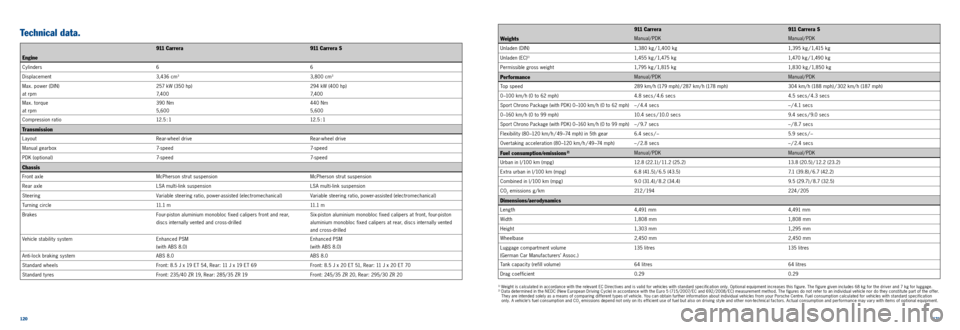
120121
9 11 C a r r e r a9 11 C a r r e r a S
Engine
C y linders 6 6
Displacement 3,436 cm
33,800 cm3
Max. power (DIN)
at rpm 257 kW (350 hp)
7, 4 0 0 294 kW (400 hp)
7, 4 0 0
Max. torque
at rpm 390 Nm
5,600 440 Nm
5,600
Compression ratio 12.5 : 1 12.5 : 1
Transmission
LayoutRear-wheel drive Rear-wheel drive
Manual gearbox 7-speed 7-speed
PDK (optional) 7-speed 7-speed
Chassis
Front axleMcPherson strut suspension McPherson strut suspension
Rear axle LSA multi-link suspension LSA multi-link suspension
Steering Variable steering ratio, power-assisted (electromechanical) Variable steering ratio, power-assisted (electromechanical)
Turning circle 11. 1 m 11. 1 m
Brakes Four-piston aluminium monobloc fixed calipers front and rear,
discs internally vented and cross-drilled Six-piston aluminium monobloc fixed calipers at front, four-piston
aluminium monobloc fixed calipers at rear, discs internally vented
and cross-drilled
Vehicle stabilit y system Enhanced PSM
(with ABS 8.0) Enhanced PSM
(with ABS 8.0)
Anti - lock braking system ABS 8.0 ABS 8.0
Standard wheels Front: 8.5 J x 19 ET 54, Rear: 11 J x 19 ET 69 Front: 8.5 J x 20 ET 51, Rear: 11 J x 20 ET 70
Standard tyres Front: 235/40 ZR 19, Rear: 285/35 ZR 19 Front: 245/35 ZR 20, Rear: 295/30 ZR 20
9 11 C a r r e r a9 11 C a r r e r a S
Weights
Manual/PDK Manual/PDK
Unladen (DIN) 1,380 kg / 1,400 kg 1,395 kg / 1,415 kg
Unladen (EC)
1)1,455 kg / 1,475 kg 1,470 kg / 1,490 kg
Pe r m issi b le gross we igh t 1,795 kg / 1,815 kg 1,830 kg / 1,850 kg
PerformanceManual/PDKManual/PDK
Top speed 289 km/ h (179 mph) / 287 km/ h (178 mph) 304 km/ h (188 mph) / 302 km/ h (187 mph)
0 –100 km/ h (0 to 62 mph) 4.8 secs / 4.6 secs 4.5 secs / 4.3 secs
Sport Chrono Package (with PDK) 0 –100 km/ h (0 to 62 mph)– / 4.4 secs – / 4.1 secs
0 –160 km/ h (0 to 99 mph) 10.4 secs / 10.0 secs 9.4 secs / 9.0 secs
Sport Chrono Package (with PDK) 0 –160 km/ h (0 to 99 mph)– / 9.7 secs – / 8.7 secs
Flexibilit y (80 –120 km/ h / 49 –74 mph) in 5th gear 6.4 secs / – 5.9 secs / –
Overtaking acceleration (80 –120 km/ h / 49 –74 mph) – / 2.8 secs – / 2.4 secs
Fuel consumption/emissions 2)Manual/PDKManual/PDK
Urban in l/100 km (mpg) 12.8 (22.1) / 11.2 (25.2) 13.8 (20.5) / 12.2 (23.2)
Extra urban in l/100 km (mpg) 6.8 (41.5) / 6.5 (43.5) 7.1 (39.8) / 6.7 (42.2)
Combined in l/100 km (mpg) 9.0 (31.4) / 8.2 (34.4) 9.5 (29.7) / 8.7 (32.5)
CO
2 emissions g/km 212 / 194 224 / 205
Dimensions/aerodynamics
Length4,491 m m 4,491 m m
Width 1,808 mm 1,808 mm
Height 1,303 mm 1, 2 9 5 m m
Wheelbase 2,450 mm 2,450 mm
Luggage compartment volume
(German Car Manufacturers’ Assoc.) 135 l i t res
135 l i t res
Tank capacity (refill volume) 64 litres 64 litres
Drag coef ficient 0.29 0.29
1) Weight is calculated in accordance with the relevant EC Directives and is valid for vehicles with standard specification only. Optional equipment increases this figure. The figure given includes 68 kg for the driver and 7 kg for luggage.2) Data determined in the NEDC (New European Driving Cycle) in accordance with the Euro 5 (715/2007/ EC and 692/2008/ EC) measurement method. The figures do not refer to an individual vehicle nor do they constitute part of the of fer.
They are intended solely as a means of comparing dif ferent t ypes of vehicle. You can obtain further information about individual vehicles from your Porsche Centre. Fuel consumption calculated for vehicles with standard specification
only. A vehicle‘s fuel consumption and CO
2 emissions depend not only on its ef ficient use of fuel but also on driving st yle and other non -technical factors. Actual consumption and per formance may var y with items of optional equipment.
Technical data.
Page 61 of 63
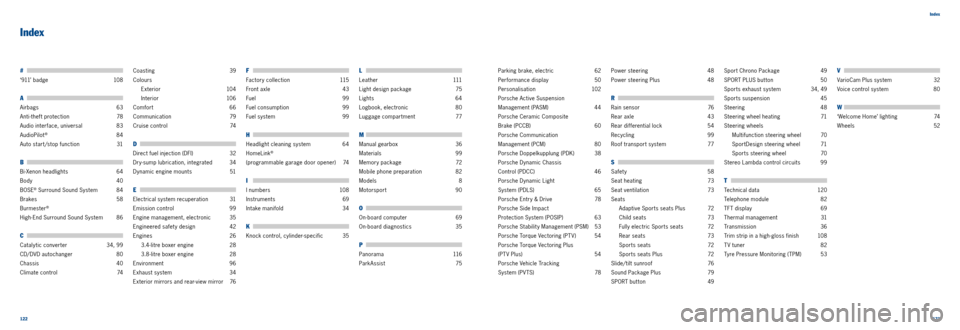
122123
Index
#
‘911’ badge
108
A
Airbags 63
Anti-theft protection 78
Audio interface, universal 83
AudioPilot
® 84
Auto start/stop function 31
B
Bi-Xenon headlights 64
Body 40
BOSE
® Surround Sound System 84
Brakes 58
Burmester
®
High-End Surround Sound System 86
C
Cataly tic converter 34, 99
CD/ DVD autochanger 80
Chassis 40
Climate control 74Coasting
39
Colours Exterior 104
Interior 106
Comfort 66
Communication 79
Cruise control 74
D
Direct fuel injection (DFI) 32
Dry-sump lubrication, integrated 34
Dynamic engine mounts 51
E
Electrical system recuperation 31
Emission control 99
Engine management, electronic 35
Engineered safety design 42
Engines 26
3.4-litre boxer engine 28
3.8-litre boxer engine 28
Environment 96
Exhaust system 34
Exterior mirrors and rear-view mirror 76
F
Factory collection 115
Front axle 43
Fuel 99
Fuel consumption 99
Fuel system 99
H
Headlight cleaning system 64
HomeLink
®
(programmable garage door opener) 74
I
I numbers 108
Instruments 69
Intake manifold 34
K
Knock control, cylinder-specific 35
L
L e a t h e r 111
Light design package 75
Lights 64
Logbook, electronic 80
Luggage compartment 77
M
Manual gearbox 36
Materials 99
Memory package 72
Mobile phone preparation 82
Models 8
Motorsport 90
O
On-board computer 69
On-board diagnostics 35
P
Panorama 116
Park Assist 75 Parking brake, electric
62
Performance display 50
Personalisation 102
Porsche Active Suspension
Management (PASM) 44
Porsche Ceramic Composite
Brake (PCCB) 60
Porsche Communication
Management (PCM) 80
Porsche Doppelkupplung (PDK) 38
Porsche Dynamic Chassis
Control (PDCC) 46
Porsche Dynamic Light
System (PDLS) 65
Porsche Entry & Drive 78
Porsche Side Impact
Protection System (POSIP) 63
Porsche Stabilit y Management (PSM) 53
Porsche Torque Vectoring (PT V) 54
Porsche Torque Vectoring Plus
(PT V Plus) 54
Porsche Vehicle Tracking
System (PV TS) 78Power steering
48
Power steering Plus 48
R
Rain sensor 76
Rear axle 43
Rear differential lock 54
Recycling 99
Roof transport system 77
S
Safety 58
Seat heating 73
Seat ventilation 73
Seats Adaptive Sports seats Plus 72
Child seats 73
Fully electric Sports seats 72
Rear seats 73
Sports seats 72
Sports seats Plus 72
Slide/tilt sunroof 76
Sound Package Plus 79
SPORT but ton 49Sport Chrono Package
49
SPORT PLUS but ton 50
Sports exhaust system 34, 49
Sports suspension 45
Steering 48
Steering wheel heating 71
Steering wheels Multifunction steering wheel 70
SportDesign steering wheel 71
Sports steering wheel 70
Stereo Lambda control circuits 99
T
Technical data 120
Telephone module 82
TFT display 69
Thermal management 31
Transmission 36
Trim strip in a high-gloss finish 108
T V tuner 82
Tyre Pressure Monitoring (TPM) 53
Index
V
VarioCam Plus system 32
Voice control system 80
W
‘Welcome Home’ lighting 74
W heels 52
Page 62 of 63
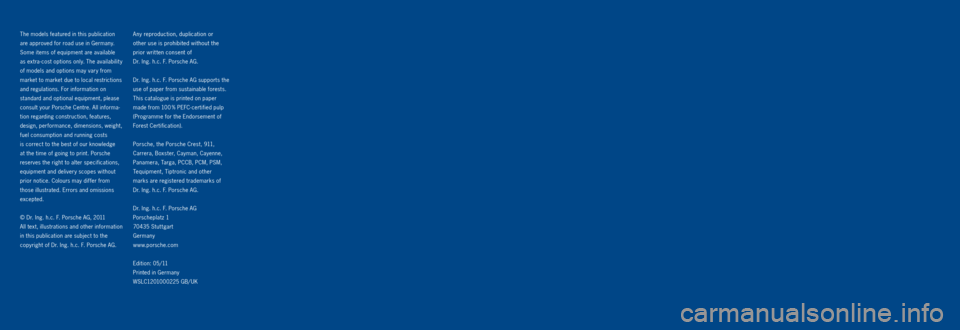
The models featured in this publication
are approved for road use in Germany.
Some items of equipment are available
as extra-cost options only. The availabilit y
of models and options may vary from
market to market due to local restrictions
and regulations. For information on
standard and optional equipment, please
consult your Porsche Centre. All informa -
tion regarding construction, features,
design, performance, dimensions, weight,
fuel consumption and running costs
is correct to the best of our knowledge
at the time of going to print. Porsche
reserves the right to alter specifications,
equipment and delivery scopes without
prior notice. Colours may differ from
those illustrated. Errors and omissions
excepted.
© Dr. Ing. h.c. F. Porsche AG, 2011
All text, illustrations and other information
in this publication are subject to the
copyright of Dr. Ing. h.c. F. Porsche AG.Any reproduction, duplication or
other use is prohibited without the
prior written consent of
Dr. Ing. h.c. F. Porsche AG.
Dr. Ing. h.c. F. Porsche AG supports the
use of paper from sustainable forests.
This catalogue is printed on paper
made from 100 % PEFC-certified pulp
(Programme for the Endorsement of
Forest Certification).
Porsche, the Porsche Crest, 911,
Carrera, Boxster, Cayman, Cayenne,
Panamera, Targa, PCCB, PCM, PSM,
Tequipment, Tiptronic and other
marks are registered trademarks of
Dr. Ing. h.c. F. Porsche AG.
Dr. Ing. h.c. F. Porsche AG
Porscheplatz 1
70435 Stut tgart
Germany
www.porsche.com
E d i t i o n : 0 5 / 11
Printed in Germany
WSLC1201000225 GB/UK